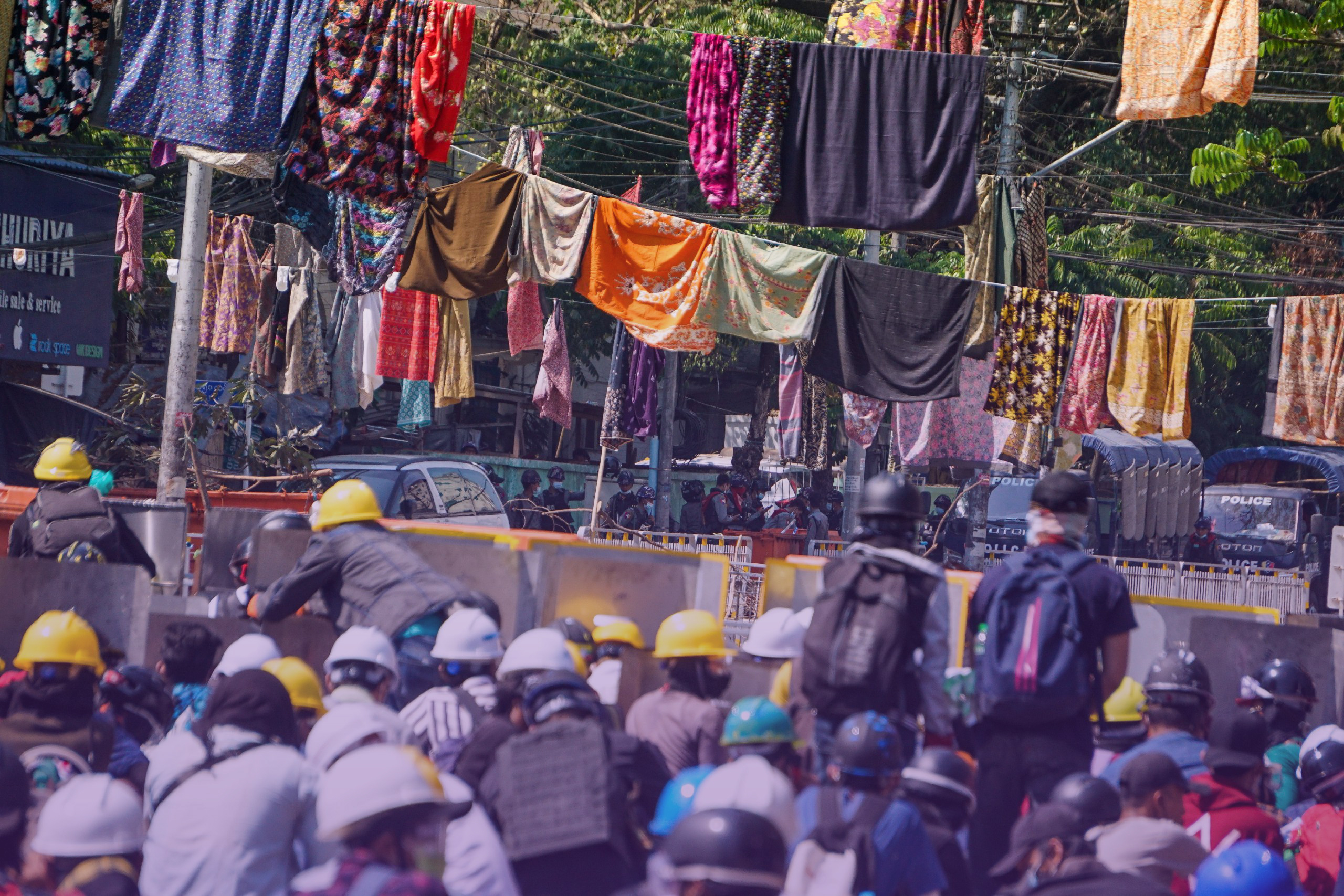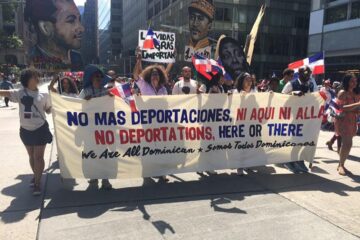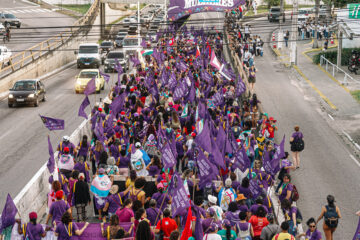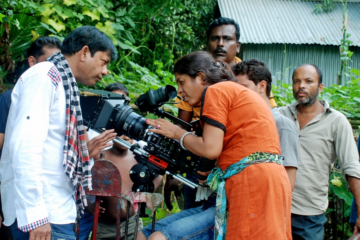Since the beginning of 2020 we have been following the violent results of the military coup in Myanmar. This country in the southeast of Asia, also known as Burma, have a history of dictatorial governments that were democratically ended in 2011 and now is back in power. The Malayan Debbie Stothard talked to Capire about this current situation. Debbie is working to support human rights and democracy in the country since 1988. She is the coordinator of ALTSEAN, a support network for Burmese democracy which includes activists, NGOs, academics and politicians from South East Asia. ALTSEAN was founded in 1996 as an alternative network from the Association of Southeast Asian Nations (ASEAN), a political and economical agreement established on 8 August 1967 on 11 countries.
One of the key agendas of ALTSEAN is the visibility of women activists in social movements in Myanmar, specially the visibility of the burman women, who is considered the majority ethnic group. “The history of resistance in the country very much depended on women’s leadership, but then they were invisible. We are very proud of the fact that this program has run continuously since 1996 and has contributed to inter-ethnic women solidarity and leadership”, explains Debbie. Read the interview she gave to Capire bellow.
Myanmar is the victim of a long dictatorial military regime that ended in 2011 and took back power this year through a coup. Could you contextualize us politically about the country’s history and how it reflects in the current political crisis?
Myanmar was democratic from 1948 until 1962. It became independent of Britain in 1948 and then in 1962 there was a military coup that firmly put the country under a military dictatorship for several decades. Back in the 90s ASEAN countries basically saw the military regime in Burma or Myanmar as an internal matter, despite the fact that this regime had held an election in 1990. They lost the election and they refused to hand over power, and it took 30 years for a transition to take place. Most people in the Burma movement saw ASEAN as pro-junta.
The country has been in a state of civil war for six decades. Last year, for example, the military had attacked and injured targeted civilian communities. There were 1024 deaths in one year taking place in 10 out of the 14 states of the country happening during the covid-19 pandemic. The military attacks even included ethnic minority health checkpoints. Also, the military has for many decades used rape and sexual violence against women and girls and even men as a way of terrorizing and humiliating local communities.
The fight against military impunity was very much spearheaded an anchored by feminists. They were across the country and in different communities documenting and denouncing the impunity, reminding the women resolutions for peace and security, continually demanding safety and protection of civilians and accountability for crimes. In Myanmar/Burma women started to take a leadership against the coup.
Even as the country moved towards more democratic governments, the figure of Min Aung Hlaing continued to have prestige. Thisgave him a political support for the coup. What made the military so politically relevant, even after the establishment of a democratically elected government in 2015?
In 2011, when the military junta was transformed into a civilian government, the military control of politics and economics had not been reduced. Between 2011 and 2020, in within the nine years of this so-called transition, the number of attacks targeting and injuring civilians rose by 143%. The amount of the national budget given to the military rose by 180%. Before this transition, many stakeholders, including countries from the west, supported a compromise position saying that the military must be part of the solution. The military oversaw the drafting of a new Constitution which was adopted in 2008, that grants the commander-in-chief of the military the power to recommend who should be Home Affairs Minister, Defence Minister and Border Affairs Minister. These are keys security portfolios.
The military also dictated that the president of the country must not have been married to a foreigner, it must be someone who is well acquainted with military affairs, and the military gave itself immunity from prosecution. They insured in the Constitution that the military is given automatically 25% of the seats in any Parliament, national, state or regional Parliament. What also happened is that the military did not relinquish power of many key enterprises, companies that actually pay dividends directly to military units.
Can you tell us a bit more specifically about last year and what is going on in the country now?
The Union Solidarity and Development Party (USDP), a military allied party, receive a lot of support and capacity-building in order to compete in the election. In 2010 the election was won by this party because the The National League for Democracy (NLD), the non military party, was not allowed to run. In the election in 2015 the NLD, which is led by Aung San Suu Kyi, was allowed to run and won by a landslide. The NLD took over government but it didn’t have full control of the government and control over some parts of the civil administration because of military power.
In 2020, in November, there was another general election and, despite all the efforts and all the resources put into the military aligned policy, they still lost. They actually lost more seats to other ethnic-based parties. The military and the USDP alleged that there was electoral fraud, a little bit similar to what Donald Trump did in the US. But in this case the difference is that the people who were saying that had guns.
On, February 1st, when the recently elected members of parliament gathered in the capital of Naypyitaw, they were locked into their accommodation and prevented from going to the Parliament. Then the coup was announced. A few days earlier, the commander-in-chief senior general Min Aung Hlaing, head of the army, had been in very heated negotiations with Aung San Suu Kyi, head of the NLD party, in order to demand that she allows him to become the president. When she refused, he declared the coup.
By the Constitution, which was drafted under the power of the military, only the president can declare a state of emergency. But senior general Min Aung Hlaing arrested the president and, then, the military vice president declared a state of emergency. They are illegal even under their own laws. Anyway, as far as we’re concerned, this coup it’s not complete because the military does not have legal, economical or territorial control on the country.
Firstly, young women leaders came out on the streets and protested against the coup. The women labor leaders, especially the factory workers in the garment industry, came out on the streets. The civil disobedience movement was started by medical workers who wanted to emulate satyagraha, the civil disobedience model promoted by Mahatma Gandhi. The first person killed by the military at an anti-coup protest was a young woman, in Naypyidaw. In the beginning of the movement it was estimated that 60% of the protesters were women.
Women break many taboos in this movement. In the traditional Burman view, in the spiritual hierarchy, men are higher than women, and the sarong is considered very spiritually and clean. So women were socialized to, when they do the laundry, wash that separately from men’s clothes. Also that when they wash these things, they have to hang it in a low place so that it will not touch a man. It is a big superstition. What we saw was that women started hanging their sarongs on clothes lines across the street and then, when the police and the military trucks come, they don’t want to drive underneath the women’s clothes because it would be bad luck for them. They will normally stop and try to break the clothes like to drag down the women’s clothes so they can drive over it instead of driving under it. This is very useful in order to slow down the military vehicles when they come into local neighborhoods.
It is significant that the military coup took place after the arrest of one of the country’s political icons, Aung San Suu Kyi, and that the first person killed during the protests was a woman. What are the impacts of violence and criminalization of militancy on the lives of women in Myanmar?
Mya Thwet Thwet Khine was the first known death of this ongoing coup. There seems to be a violence that targets children also. It really creates the sense that nobody is safe. People are continually on the threat of being arrested, of being shot, of being beaten up, and still they go out and protest. They find ways to resist. This atmosphere of fear and violence is very much an extension of what was being felt in many conflict areas, but now it’s happening everywhere in the country.
In one very dramatic case on March 16th, there was a labor dispute in the industrial zone of Hlaing Thar Yar near Yangon. The workers went to get their wages but the management gave them less money, so they had a dispute and the management called the police. The police and military came into that area and slapped the woman who was leading the striker. When she slapped him back, he shot her dead in front of her colleagues and shot dead five other strikers. Then the police arrested 70 of these workers.
The resistance is still going on, despite the extreme cruelty, despite the military showing photos of young women before and after they were detained, showing young women activist being roughed up and looking traumatized and injured on national TV to show how they will punish people.
Women and workers have been mobilizing a lot to face the coup, with strikes and mobilizations. Could you tell us a little about the strategies for articulating social movements and the dynamics of international solidarity?
In Asia there has been a phenomenon of young activists fighting for human rights and democracy. There is also solidarity from the more traditional networks such as labor movements. The majority of the workforce in the garment factories of Myanmar are women. In the general strikes held around the country, there is a lot of women leaders who are workers in these factories.
One of the interesting things that happened was that some of the women labor activists here heard that Amazon workers in the US were on strike. We were surprised to see photos on social media that, as they were striking against the coup, they held up posters in solidarity with Amazon workers. That feeling of international solidarity is a two-way process.
It is important, firstly, that the women leading this movement and participating in their communities understand that they are not alone, not forgotten. Secondly, we need to listen to their voices. They want the 2008 Constitution to be abolished, they want companies and countries to apply sanctions and boycotts on military materials, they also want people to understand that the junta is illegal therefore companies should not be paying taxes or revenues to the junta. At this point, now we are faced with two choices: the National Unity government which represents 76% of the elected members of parliament and ethnic groups or the illegal military junta which broke its own Constitution to grab power and which is killing people in the streets everyday.
The results of national elections and the strength which people have been taking to the streetsdemonstrates a national desire for a democratic political regime.. What are the country’s feminist political forces and how are they acting during this popular wave of protests?
One of the leading feminist forces is the Women’s League of Burma, which is an umbrella group 13 ethnically-based women’s organizations. They have been doing a huge amount of documentation and legal work on combating impunity in the country. A lot of the work that they’re doing is incredibly important but it is not yet the time that we can safely share it because we already saw one of its members being assassinated and another one being taken away for interrogation and prevented from having legal assistance.
They are working very hard to secure the safety of women and human rights defenders and their families. Their voices are very strong. The question is whether the rest of the world wants to listen to those voices. It’s really important and urgent for all of us to ensure that their voices are heard, for the protection of civilians, for hope, for accountability and a federal democratic system which is inclusive and respects the rights of the people.




